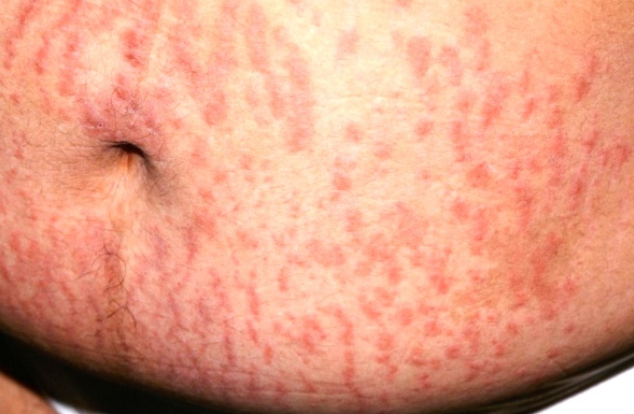Pruritic urticarial papules and plaques of pregnancy, also known as polymorphic eruption of pregnancy, is a benign, self-resolving inflammatory skin condition that occurs in pregnant women. It is characterized by pruritus and a polymorphous rash. Its ICD-10 code is O26.8.
The average age of onset is 25 years, with a range of 16-40 years. It is the most common dermatosis of pregnancy, occurring in 1 in 160 pregnancies, with a frequency of 0.5-0.62%.
Most cases occur in the late third trimester of pregnancy, but the condition can also develop in the first and second trimesters. It rarely begins in the postpartum period (3-10 days after delivery).
The exact etiology and pathogenesis of pruritic urticarial papules and plaques of pregnancy are not fully understood. It is possible that the development of the condition in late pregnancy is related to the stretching and straining of the abdominal muscles and skin, resulting in damage to connective tissue fibers, acquisition of antigenic characteristics, stimulation of immune inflammation, and so on. It is also possible that the condition is related to the maternal immune response to paternal antigens expressed by the fetal part of the placenta.
There is no evidence of an autoimmune process in pruritic urticarial papules and plaques of pregnancy. The frequency of HLA alleles in affected individuals is the same as in controls. The condition is more likely to develop in full-term pregnancies, with large fetuses, or in multiple pregnancies.The disease typically begins with the appearance of red papules, often surrounded by a pale halo. In 90% of patients, the first signs of the disease appear on the abdomen. Women with stretch marks often have rashes within or around the stretch marks. The eruptions spread symmetrically over several days, and in 50% of patients the process extends to other areas of the body, including the buttocks, chest, back, legs, arms, and backs of the hands. The palms, soles, and face are usually not affected.
The number of lesions increases rapidly and they become more polymorphic, forming new vesicles 1-2 mm in diameter and diffuse urticarial erythema. Unlike urticaria, these lesions remain unchanged and do not disappear until childbirth. Blisters are not usually seen. Pruritus may range from moderate to severe and excoriations are rare.
The average duration of the disease is 6 weeks, but after 1-3 weeks the eruptions usually become less severe. There are no associated complications during pregnancy and childbirth. Recurrences in subsequent pregnancies are atypical and infants do not develop eruptions. If vesicles and blisters develop, direct immunofluorescence should be performed to rule out herpes in pregnant women.Usually, the clinical presentation is sufficient for diagnosis. To distinguish pruritic urticarial papules and plaques of pregnancy from pemphigoid gestationis, immunofluorescent staining may be required, especially if vesicles are present among the rash elements.
Histopathological changes are nonspecific. In the early stages of the disease, the main changes are observed in the dermis (edema, perivascular inflammatory infiltrate, mainly consisting of lymphocytes, histiocytes, eosinophils), whereas in the late stages, changes in the epidermis predominate (spongiosis, hyperkeratosis, parakeratosis).- Pemphigoid gestationis
- Atopic eczema in pregnancy
- Impetigo
- Cholestasis in pregnancy
- Urticaria
- Drug eruptions
- Erythema multiforme
- Allergic contact dermatitis
- Insect bites
- Scabies
Treatment is primarily supportive. Pruritus can be relieved by prescribing topical steroids of groups II-V, moist cool compresses, and anti-pruritic lotions.
In severe cases (fexofenadine, cetirizine, loratadine, hydroxyzine with sedative, anxiolytic, M-cholinolytic and antiemetic effects) are recommended. Systemic corticosteroid therapy may be necessary (prednisolone at a daily dose of 40-60 mg for several days, with a gradual dose reduction).
